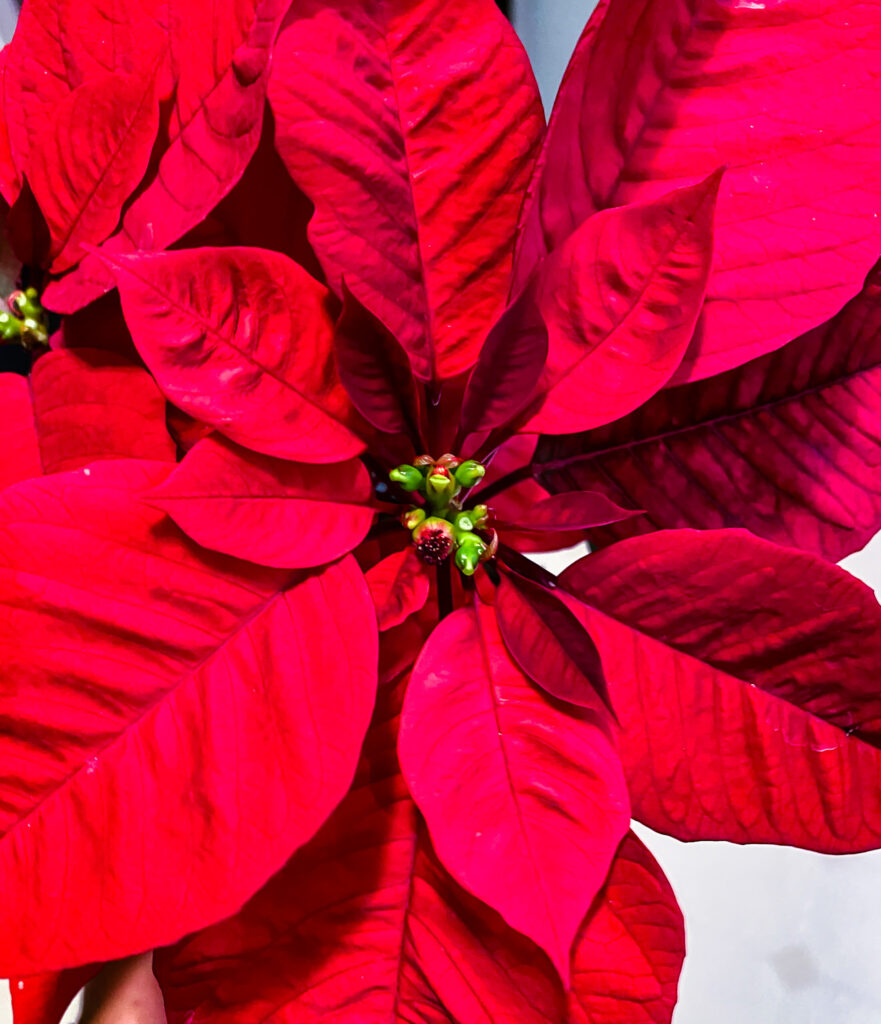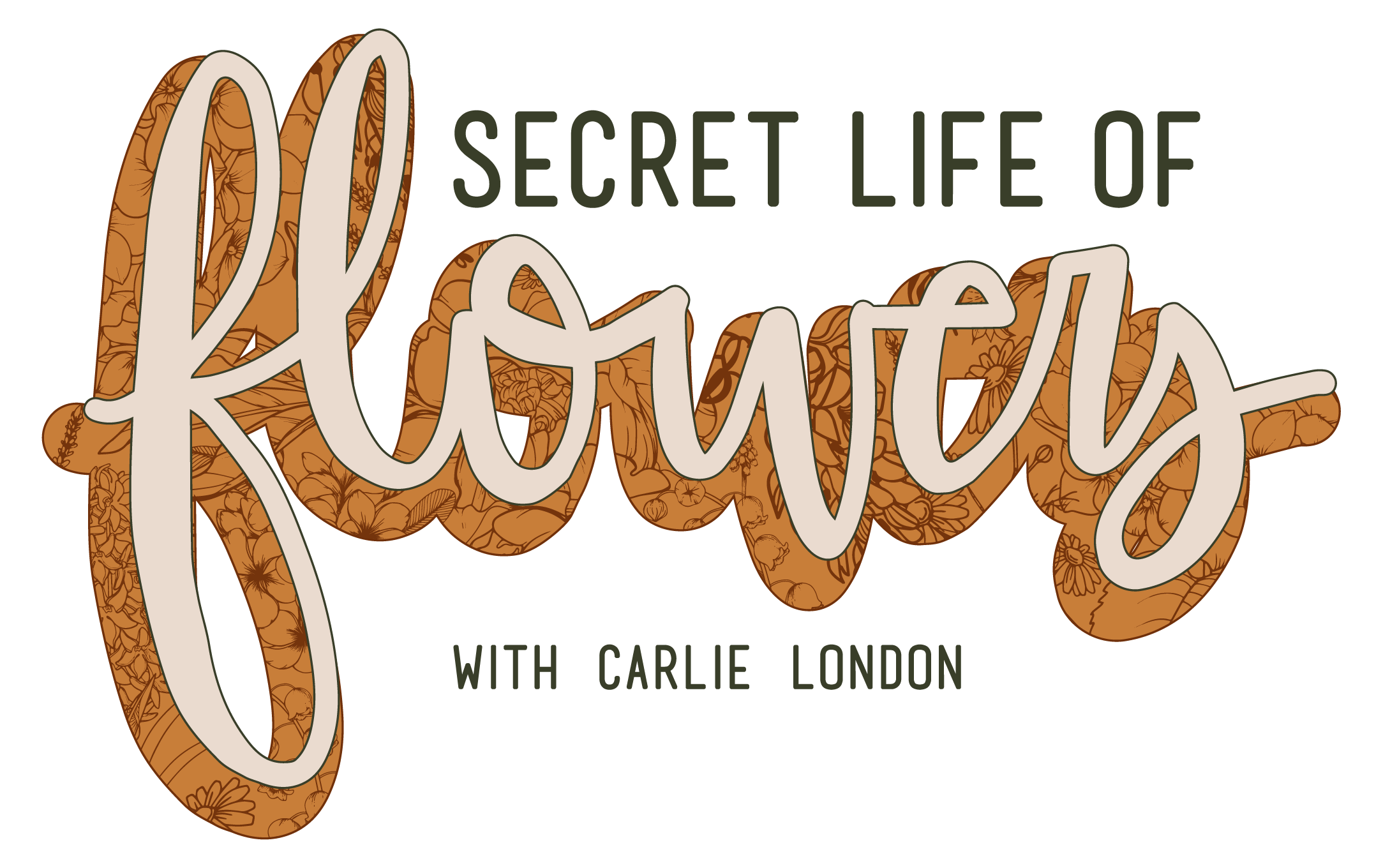Poinsettia
Poinsettia – Podcast S1 E5 – December 17, 2020
Poinsettia, the December birth flower!
They are of the euphorbiaceae family. These flowers are native to Central America, more specifically southern Mexico. This plant was not described in European history until 1834. Poinsettias are also known as the Christmas Star, and Christmas flower. The ancient Aztecs called them cuetlaxochitl.

What is the language of Poinsettias?
- good cheer
- success
- wishes of mirth
- celebration
- purity (this is not widely recognised anymore, it was what Poinsettias symbolised to the Aztecs)
This is one of the few flowers that, regardless of colour, it means the same thing. You may be thinking “Aren’t all poinsettias red?” While, that is the colour most of us think of or picture, poinsettias can also be pink, white, or green.
Pair with Purpose
- Planning for a winter wedding and wanting to say good cheer, mirth, and celebration? Pair your poinsettias with Chrysanthemum, Jessamine, Tickseed, Saffron Crocus, Elder, Wild Grape, & Rosa Muni.
- If you want to make a beautiful celebratory bouquet for Christmas dinner, try pairing Poinsettias with Pine, White Zinnia, Star of Bethlehem, green Dianthus, & Hellebore (also known as the Christmas Rose).
- If you are just going for a classic Christmas look then decorate your home with the classic red potted poinsettias.
How did they become the flower of Christmas?
- Legend has it, a child named Maria was too poor to give gifts for Christmas. An angel came to her and told her to collect weeds from the roadside instead. She laid these weeds at the Christmas Eve alter and the church witnessed a miracle. The weeds that she laid blossomed into beautiful red and green leaves. This is how the colours of Christmas became red and green.
- After that, Franciscan friars began using them for certain celebrations because the star shape symbolised the Star of Bethlehem and the red colour symbolised the crucification of Jesus Christ.
- In Peru & Chile, the poinsettia is know know as the Crown of the Andes while in Spain, it is a traditional Easter flower.
- An amateur botanist and first United States Ambassador to Mexico, Joel Roberts Poinsett, introduced the plant to the US in 1825. He traveled to Mexico, where he encountered the flowers and sent them back to his home greenhouses in South Carolina. His last name is how they became Poinsettias. Before the renaming they were called “Painted Leaf” & “Mexican Flame Flower.”
- Poinsettias are also known by various names all over the world, such as, Mexican Flame Leaf, Winter Rose, Noche Buena, painted leaf, and Atakurk’s Flower.
- A random fun side bit, the part we tend to refer to as the flower (the big red star shape) is actually leaves. They are a special kind of leaves called bracts. The flower is the smaller, compact area, in the middle of those leaves.
Poinsettia Uses
*Just a reminder, I am not a herbalist, I am just sharing some of the uses for Poinsettias that I have learned.*
- The whole plant and it’s sap (known as latex) are used to make medicine.
- People take poinsettia to reduce fever, stimulate breast milk production, and cause an abortion.
- They also use the latex for pain (one example being toothaches), to kill bacteria, and cause vomiting.
- Some apply the latex directly to the skin to treat warts, remove hair, and heal other skin disorders.
- WebMD says there is not good scientific evidence to support any of this.
- Poinsettias are not as toxic as they were once believed to be.
- There are some possible side affects – if eaten some have experienced mouth sores, nausea, upset stomach, vomiting, and diarrhoea. When applied to the skin poinsettia is possibly unsafe and some of reported skin rash, eye irritation, and irritations or burns to the mouth.
- According to poison.org, they are not deadly like we have lead to believe. They can be irritating but not fatal if pets or children eat them.
- A study at Ohio State University found that a 50-pound child would have to eat more than 500 leaves to have a harmful effect. Also, poinsettia leaves taste horrible so you don’t have to worry about a child eating 500+ leaves.
- Poinsettias are also popular for making dyes.
What can you do to keep yours alive and thriving, before and after the holidays?
- Poinsettias like a lot of indirect light and normal room temperatures. They don’t like cold or hot so keep them away from heat sources and places with cold drafts.
- Allow the soil to dry between waterings and then give it a good watering. However, don’t let the pot sit in a saucer of water because too much water will cause the roots to rot.
- Most of the time people throw their poinsettias out and buy new ones each year. So, you may not realise that you can actually keep them and not have to buy new ones each year.
Want to keep yours after the holidays so you don’t have to re-buy? Here is what you do:
- January to September is your basic care. Continue keeping your plant indoors after Christmas, with bright indirect light, regular watering, and well-draining soil. They will stay in bloom for about four months and then the bract leaves will start loosing their colour.
- In late April, cut the flowers back 4-6 inches, or 1/3. If you want a more compact plant then leave only 2-3 leaves on each stem. May is a good time to re-pot your poinsettia into a new, bigger pot, and place in a sunny window. Only water when the soil is dry.
- In June, when the risk of frost is gone, move your potted Poinsettia outside to a shady spot. Water and fertilise regularly, don’t let it wilt but don’t over water it and fertilise with a less phosphorus, labeled 17-5-19 (if you can find it) or an all-purpose 20-20-20 will work if you can’t. Fertilise more regularly, bi-weekly, once the plant starts getting new growth.
- When the evening temperatures start to drop, in August or September, then move your plant back inside.
- September to December is the intensive care months. It isn’t hard, it just takes more time.
- Your poinsettia will need to get 12-16 hours of complete darkness every day, for about ten weeks. Everywhere I researched said different time amounts so…take your pick. This is essential in the plant re-flowering. It needs to be completely dark. Not even a glimmer of light during their dark time. I suggest covering your plant with something opaque and putting it in a closet you don’t get into very often.
- In the morning move your poinsettia to a sunny spot for their sun-time. Probably a good idea to set two daily reminders so you remember to move your plant to the sun and then back to their dark corner in the evening.
Grow From Seed?
- Interested in growing your poinsettia from seeds? Poinsettias grow their seeds inside a bulbous seed pod. If you are buying seeds from the store or a nursery then you will not have to figure out how to collect them from a seed pod. I just thought that was cool and wanted to share.
- In order for those seeds to germinate they need to be in a cold dark place for about three months (I’m not sure if it has to be that long if you are buying the seeds verses harvesting them yourself) – I suggest putting them in your refrigerator.
- After their cold stint, plant them under about an inch and a half of soil.
- Your seeds may take several weeks to sprout. Don’t worry if they don’t grow right away.
- Keep the soil warm and moist while you wait for them to begin growing.
Well, folks! That is all I have for Poinsettias! I hope you learned something new!
If you have heard any other uses, meanings, or are an expert then I would love you to leave a comment and share what you know, or have learned, with the rest of us! If you are interested in purchasing ad space or paying for a friend’s birthday shout out, then fill out the contact form.
You will find all of my sources, under the sources tab.

ˣˣˣ
Today a reader,tomorrow a leader!